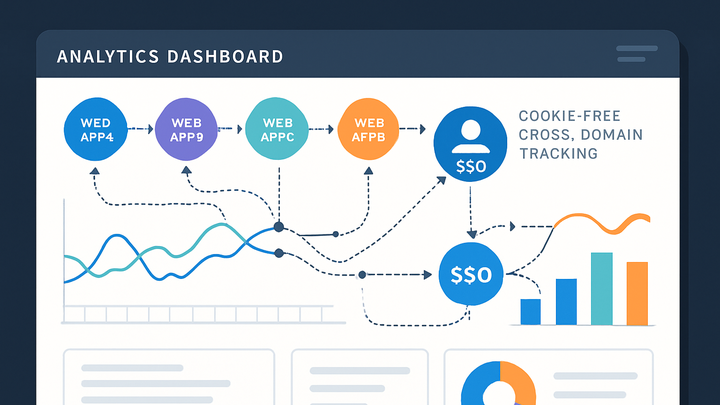Published on 2025-06-22T09:43:56Z
What is SSO Analytics? Examples & Best Practices
SSO Analytics leverages Single Sign-On (SSO) authentication as a consistent, privacy-friendly user identifier to track interactions across multiple domains or applications. By using the SSO provider’s stable user IDs, businesses can maintain accurate cross-domain session stitching without relying on third-party cookies. This approach solves common tracking challenges such as cookie blocking, deletion, and fragmentation, while improving data quality and user privacy compliance. Platforms like PlainSignal (cookie-free) and Google Analytics 4 support SSO-based tracking to unify user journeys across sign-in flows and digital touchpoints. Implementing SSO Analytics ensures a single source of truth for user behavior, enabling richer segmentation, personalized experiences, and robust insights.
As privacy regulations evolve and browser restrictions tighten, SSO Analytics emerges as a resilient strategy for modern measurement. It protects user data, simplifies compliance with GDPR/CCPA, and empowers analytics teams to deliver trustworthy insights.
Sso analytics
Track users across domains using SSO IDs for accurate, cookie-free analytics that enhance privacy and data consistency.
Why SSO Analytics Matters
SSO Analytics addresses core limitations of traditional cookie-based tracking by using a centralized authentication identifier. This ensures:
-
Privacy compliance
Reduces reliance on third-party cookies and aligns with GDPR, CCPA, and other privacy regulations by using consented authentication data instead of device fingerprints.
-
Accurate cross-domain tracking
Maintains a single user identity across multiple domains or subdomains, preventing session fragmentation and duplicate user counts.
-
Unified user journeys
Aggregates interactions before and after login into one continuous timeline, enabling deeper insights into onboarding, engagement, and retention.
Key Benefits of SSO Analytics
Implementing SSO Analytics unlocks several advantages for analytics teams and business stakeholders:
-
Cookie-free tracking
By leveraging SSO tokens instead of browser cookies, you avoid blockers and deletions that lead to data loss.
-
Improved data accuracy
A single, persistent identifier reduces duplication and false new-user counts, yielding cleaner datasets.
-
Consolidated user profiles
Merge pre-login and post-login behavior into one profile, powering personalized messaging and targeted campaigns.
-
Streamlined compliance
Centralize consent management through your SSO provider, simplifying audit trails and user data requests.
Implementation Steps
A high-level workflow to set up SSO Analytics in your stack:
-
Configure your sso provider
Ensure your identity provider (e.g., OAuth, SAML) issues a stable user identifier (UUID or hashed email) on each login.
-
Integrate with analytics platform
Modify your analytics initialization to read the SSO user ID from the session or token and pass it as the
user_idfield. -
Map and pass user identifiers
Embed the SSO ID into data attributes or script parameters so your analytics SDK can capture it automatically.
-
Test and validate tracking
Perform end-to-end tests across domains: login, logout, cookie clearing, and new sessions to verify consistent user stitching.
Real-World Examples
Below are example configurations for two popular analytics platforms using SSO identifiers.
-
PlainSignal (cookie-free simple analytics)
Use the following tracking snippet to send events tied to your SSO identity:
<link rel="preconnect" href="//eu.plainsignal.com/" crossorigin /> <script defer data-do="yourwebsitedomain.com" data-id="0GQV1xmtzQQ" data-api="//eu.plainsignal.com" src="//cdn.plainsignal.com/plainsignal-min.js"></script>You can append a
data-user-idattribute or set it via the PlainSignal JS API after login to unify sessions across domains. -
Google analytics 4 (GA4)
In GA4, set the
user_idparameter from your SSO system to unify data:gtag('config', 'GA_MEASUREMENT_ID', { 'user_id': SSO_USER_ID });You can also send custom events with the
user_idfield via the Measurement Protocol orgtag.js. Ensure your login flow exposes a stable identifier (e.g., UUID or hashed email).
